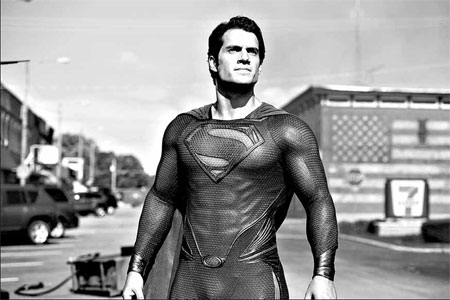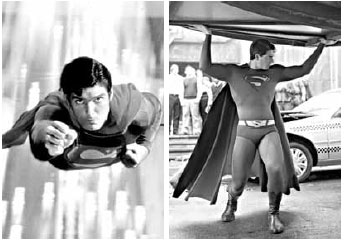Film puts 'S' back on pedestal
Updated: 2013-06-02 08:02
By Dave Itzkoff(The New York Times)
|
|||||||
|
The director said he went back to the original Superman conception in the "Man of Steel," starring Henry Cavill. Clay Enos / Warner Brothers Pictures |
|
Earlier film versions of Superman: Christopher Reeve, far left, in the 1978 film "Superman" and Brandon Routh in the 2006 film "Superman Returns." Warner brothers pictures |
BURBANK, California - In a dimly lighted editing suite here on the Warner Brothers lot, Zack Snyder was discussing his philosophy on the totemic character who arguably gave rise to every fantasy series of the last 75 years: Superman.
For too long, said Mr. Snyder, the director of "Man of Steel," a new Superman movie that Warner Brothers will release worldwide starting in mid-June, modern-day interpretations of this DC Comics superhero had been apologizing for the outdatedness of his origins; they sought to conceal him in contemporary trappings instead of embracing an essential mythology that he said was as bulletproof as the character himself.
"When they try to dress him up," Mr. Snyder said, "put him in jeans and a T-shirt or a leather jacket with an S on it, I go: 'What? Guys, it's O.K. It's Superman. He's the king daddy. You should all be bowing down to him.'"
What his film tries to do, he said, is "respect the S."
Deborah Snyder, Mr. Snyder's wife and producing partner, corrected him on one fundamental detail they had updated for "Man of Steel." "It's not an S," she said. "It's a symbol of hope."
Hope is a quality that Mr. Snyder, a director of comic-book adaptations like "Watchmen" and "300," has been clinging to as they finish work on "Man of Steel," more than two years and $175 million or more in the making.
Yes, "Man of Steel" is the latest effort to rejuvenate a decades-old pop-culture franchise and, in doing so, renew both the fortunes of Warner Brothers as it searches for new blockbusters and the career of Mr. Snyder after recent misfires. But it is being built on the back of a character who has proved particularly unsusceptible to attempts to make him more relatable. Audiences seem to want him to be grounded, at the same time that they want to believe he can fly.
It is strange that Superman, the smiling, soaring Moses-Jesus hybrid who ushered in the era of superhero comics, should be struggling at the multiplexes in an age when every other studio movie seems to feature a man in a cape, a mask with pointy bat-ears or a high-tech suit of iron. The qualities that have made Superman timeless have not necessarily made him relevant to this particular time, but it was this paradox that made Mr. Snyder eager to take him on in "Man of Steel."
"He's a really cool mythological contradiction," said Mr. Snyder. "He's incredibly familiar Americana and alien, exotic, bizarroland, but beautifully woven together."
His film stars Henry Cavill of "The Tudors'' as Kal-El, a survivor of the destroyed planet Krypton who on Earth becomes the costumed champion Superman but disguises himself as the all-too-human Clark Kent.
"Man of Steel" retains traditional elements, like Superman's tension between his natural Kryptonian father, Jor-El (Russell Crowe), and his adopted Earth dad, Jonathan Kent (Kevin Costner), and his attraction to the perpetually imperiled Daily Planet reporter Lois Lane (Amy Adams).
The film also emphasizes the world of Krypton before its annihilation - a bleak, utilitarian planet with sophisticated if downright creepy technology - and the treachery of the Kryptonian villain Zod (Michael Shannon), who finds Kal-El on Earth. The result is an unapologetic science-fiction spin on Superman, and while that may shatter audiences' expectations for pure, unalloyed realism in "Man of Steel," Mr. Snyder said this approach was built into the DNA of the character.
"If you follow him back logically and try to understand him," he said, "you end up at a sci-fi solution."
This was the same conclusion reached by Christopher Nolan, the director, and the screenwriter David S. Goyer when they first conceived of "Man of Steel."
Mr. Goyer said he never felt much connection to its hero.
But his thinking changed when he looked at Superman in his earliest incarnation, written and illustrated by Jerry Siegel and Joe Shuster in the late 1930s. Here was a character whose fundamental mythology was still in flux, whose most transformative quality had seemingly never been seized upon. "If he really were an alien," Mr. Goyer said, "when the world finds out that he exists, that in itself would be the biggest event in human history. That would change the world forever."
What drew Mr. Snyder in was a vision of the character that felt both classical and contemporary. But as the ultimate version of a familiar story, that of a young man struggling to find his place in the world - "teenage angst on steroids," Mr. Snyder called it - this Superman's tale contained elements he and Ms. Snyder had never seen before.
Ms. Snyder said, "Finding a bearded Superman on a crab boat, it was like, wait a minute, that's not the Superman that we're used to."
The New York Times
(China Daily 06/02/2013 page12)

